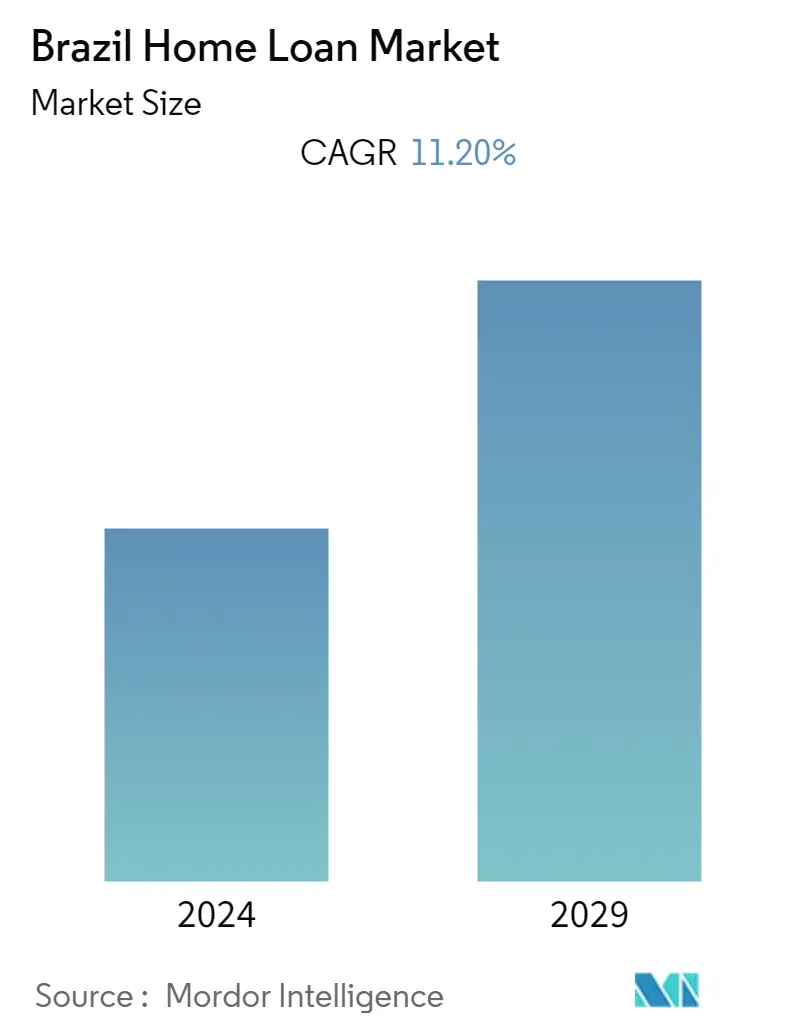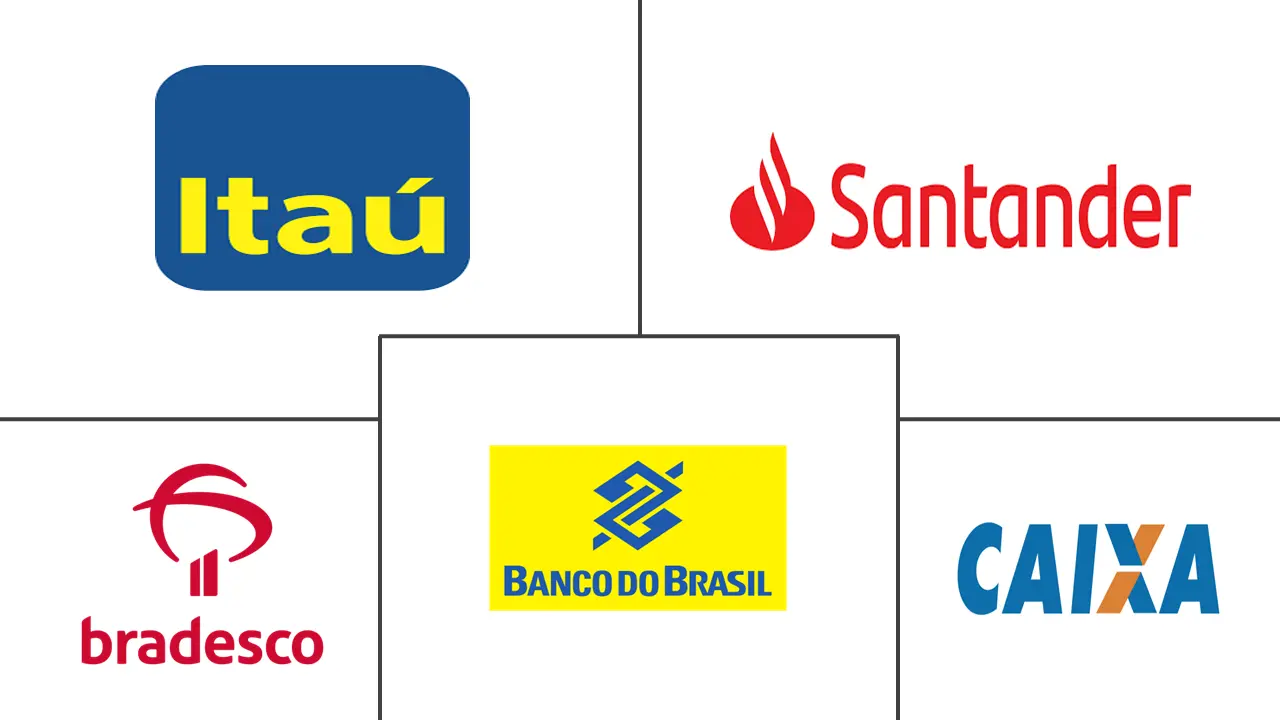Market Size of Brazil Home Loan Industry

| Study Period | 2020 - 2029 |
| Base Year For Estimation | 2023 |
| Forecast Data Period | 2024 - 2029 |
| Historical Data Period | 2020 - 2022 |
| CAGR | 11.20 % |
| Market Concentration | Medium |
Major Players
*Disclaimer: Major Players sorted in no particular order |
Brazil Home Loan Market Analysis
The Brazil Home Loan Market is valued at USD 40.9 billion and is expected to register a CAGR of 11.2% during the forecast period.
The outbreak of the COVID-19 pandemic triggered record job losses and a spike in home loan defaults, creating a potentially treacherous road ahead for borrowers and lenders. There was a dramatic drop in interest rates that sparked a mortgage boom in Brazil, making home ownership feasible for thousands and tempting to trade up or splash out on a house in the country or by the beach. Brazil's mortgage market remains in its infancy, with outstanding home loans totaling 720 billion reais (USD 135 billion), or around 10% of GDP, which is less than half the ratio in Chile and a fifth of the share in the U.S.
Brazilian mortgage lending registered its second-best in May on record, with loans totaling over USD 17 billion. The figure is almost 50% more than April and the highest so far this year. Compared to the previous 12 months, home loans have risen by 18% in the year. The Brazilian Central Bank has been steadily increasing base interest rates since late last year in an attempt to bring inflation into check. However, the rate hikes have not deterred buyers, as the latest mortgage figures show. The strong underlying demand in the market and favorable loan packages from Brazilian banks continue to drive the market. Demand is particularly acute in Northeast Brazil, where 40% of consumers are looking to buy a home. The mortgage lending increase in Brazil continued to show high rises in the first eight months of the year. Between January and August, the value of loans totaled USD 136,9 billion, up 107.7% in the year. Mortgages in August alone reached a value of USD 21.01 billion, an increase of 11.8% in July and of 79.2% in the year.
Brazil Home Loan Industry Segmentation
The home loan market refers to the financial sector that deals with the origination, servicing, and trading of loans used to finance residential properties. It is a specific segment of the broader mortgage industry. In the home loan market, lenders provide funds to individuals and families to purchase homes or refinance existing mortgages. The Brazil Home Loan Market is segmented By Source (Bank and Housing Finance Companies), By Interest Rate (Fixed Rate and Floating Rate), and By Tenure (Up to 5 Years, 6 - 10 Years, 11 - 24 Years, and 25 - 30 Years). The report offers market size and forecasts in value (USD) for all the above segments.
| By Source | |
| Bank | |
| Housing Finance Companies (HFC's) |
| By Interest Rate | |
| Fixed Rate | |
| Floating Rate |
| By Tenure | |
| Upto 5 Years | |
| 6 - 10 Years | |
| 11 - 24 Years | |
| 25 - 30 Years |
Brazil Home Loan Market Size Summary
The Brazil Home Loan Market is experiencing significant growth, driven by a combination of factors including favorable interest rates and increasing demand for home ownership. Despite the challenges posed by the COVID-19 pandemic, which initially led to job losses and loan defaults, the market has rebounded with a surge in mortgage activity. The Brazilian Central Bank's efforts to control inflation through interest rate hikes have not deterred buyers, indicating strong underlying demand. The market remains relatively underdeveloped compared to other countries, with a smaller proportion of GDP represented by outstanding home loans. This presents opportunities for growth, particularly in regions like Northeast Brazil, where there is a high demand for housing.
The luxury real estate segment in Brazil is also witnessing robust growth, fueled by rising middle-class incomes and the devaluation of the Real, which has made luxury properties more accessible to both domestic and foreign investors. The influx of tourism has further bolstered this market, as international visitors seek to invest in Brazilian real estate. Additionally, the rise of fintechs and digital banks has transformed the credit landscape, with neobanks gaining a significant foothold in the market. These digital platforms offer competitive advantages such as lower fees and user-friendly interfaces, attracting a growing customer base. The home loan market is dominated by a few key players, including Itaú Unibanco, Santander, Banco Bradesco, Banco do Brasil, and Caixa Econômica Federal, who continue to shape the industry's competitive dynamics.
Brazil Home Loan Market Size - Table of Contents
-
1. MARKET INSIGHTS AND DYNAMICS
-
1.1 Market Overview
-
1.2 Market Drivers
-
1.2.1 Economic Growth
-
1.2.2 Increased Mortgage Options
-
-
1.3 Market Restraints
-
1.3.1 Interest Rate Volatility
-
-
1.4 Industry Attractiveness - Porter's Five Forces Analysis
-
1.4.1 Bargaining Power of Suppliers
-
1.4.2 Bargaining Power of Buyers
-
1.4.3 Threat of New Entrants
-
1.4.4 Threat of Substitutes
-
1.4.5 Intensity of Competitive Rivalry
-
-
1.5 Insights on Current Trends and Innovations in the Market
-
1.6 Impact of COVID-19 on the Market
-
-
2. MARKET SEGMENTATION
-
2.1 By Source
-
2.1.1 Bank
-
2.1.2 Housing Finance Companies (HFC's)
-
-
2.2 By Interest Rate
-
2.2.1 Fixed Rate
-
2.2.2 Floating Rate
-
-
2.3 By Tenure
-
2.3.1 Upto 5 Years
-
2.3.2 6 - 10 Years
-
2.3.3 11 - 24 Years
-
2.3.4 25 - 30 Years
-
-
Brazil Home Loan Market Size FAQs
What is the current Brazil Home Loan Market size?
The Brazil Home Loan Market is projected to register a CAGR of 11.20% during the forecast period (2024-2029)
Who are the key players in Brazil Home Loan Market?
Itaú Unibanco (Itaú BBA e Rede), Santander, Banco Bradesco, Banco do Brasil and Caixa Econômica Federal are the major companies operating in the Brazil Home Loan Market.

